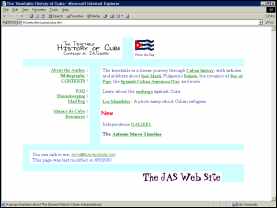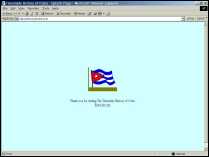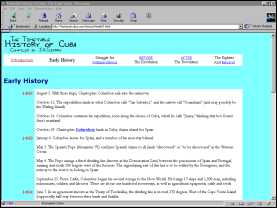
 Two Decades Online:
Two Decades Online:
History of historyofcuba.com
[This article is currently being updated.]
In the face of time, ten years is less than a drop of water on the Pacific Ocean. In the face of history, ten years is but a breath of fresh air in a long and fruitful life. In the time span of Cuban history, ten years is but one war. On the Internet in 2006, ten years is almost forever.
This website began in 1995 as a small sector in THE JAS WEB SITE, an experimental site that showcased personal content and provided me with a way to further explore HTML. The site included various short stories, an article on photomontage that I originally wrote for Petersen's Photographic Magazine, a gallery of images and a brief section on Cuban history.
In 1996 the Cuban history sector grew out of control and demanded its own environment, and THE TIMETABLE HISTORY OF CUBA emerged as its own entity, separate from the personal site. I consider this the official birth of Version One. The "timetables" consisted of a list of dates with no pictures and a few links to short articles about Martí and Maceo. By the end of that first year, the site reached a total word count of nearly 2,000 words. (Today, the word count stands at over 160,000 words.)
From the beginning, the site generated lots of Email - mostly questions about issues in Cuban history, and praise from teachers and students, who encouraged further development and complained about the inaccuracies and omissions in the history texts that school districts force on them. The Internet was a polite place for a while. Then came the many politically motivated messages from left and right wing extremists, arguing their political point of view with passion. Cuba seems to elicit a great deal of passion from those who encounter her mysterious charms.

More Than A Web Site
Over the years the site grew steadily, with peaks and valleys in development closely resembling my time availability and work calendar. At this time I also worked as a freelance writer/photographer, graphic artist and web designer, and maintained a full-time job at the San Francisco Department of Public Health. There was often little or no time for Cuban history, but I always seemed to have a couple of library books around with the word "Cuba" on the cover.
It was now time to get serious. Up to this point I had used my own books and research materials in the development of the site, drawing on over 15 years of reading in which Cuban history was one of my life's main interests. I began to take stock of the site's strengths and weaknesses, and worked to improve the overall reach of the material. It was obvious that I would have to learn about and explore topics in Cuban history that had been of little interest to me previously, such as, basically, the twentieth century.
I began to seek books and journal articles, and soon Cuban history became, again, a big passion in my life.
Millennium Fever
In 1999, as the world anticipated the dreaded millennium virus and the many end-of-the-century celebrations, I decided to devote all my "freelance time" to the site exclusively, and established the domain historyofcuba.com.
Instead of writing articles about software programs that would be outdated within a year, I could do something useful (though less financially profitable) with my time.
The site began to blossom, providing symbolically on the Internet what Martí, Maceo and many others lived, fought and died for; an independent Cuban identity, not subject to or dependent on the point of view of the empires that would control her, or the politicians that would sell her piece by piece to the highest bidders.
Over the next few years I invested a great deal of time researching, and the site went through a major restructuring period that included:
- Re-writing and expanding the timetables.
- · Cleaning up the code by hand and re-confirming the site's commitment to the W3C's accessibility guidelines and a true worldwide web audience.
- Generating new content and updating the navigation.
- Establishing a strict set of Editorial Guidelines.
- Applying the guidelines to existing work.
- Developing "systems" for maintaining and updating the site.
- Reviewing nearly 4 years of Email to seek trends and identify where the site could be improved.
Due to other projects and interests, and a 2-year return to the halls of academia, there were large periods of time in which the site remained untouched and unchanged. During these times, however, I was still reading and gathering data that would eventually appear on the site.

For a while, historyofcuba.com was the only source for online information on Cuban history, as even the major encyclopedias had little or no information on the island, and other sites had patches of information, but nothing complete or thorough. I began to spend considerably more time answering Email questions and looking for ways to turn the answers into new content, a practice that continues to this day. For example, the articles on the Sierra Maestra, Raul Castro, the Cuban flag, and the Ten Year War, to name a few, began as responses to Email questions.
A brief flirtation with HTML frames took place in the year 2000, but users discouraged this, so the practice ended within a year. Since then, a new trend emerged, as school districts openly embraced the site and this shift in usage inspired the implementation of a new "navigation model" in which the Timetables were no longer the center of the site's universe.
In May 2004, the site began another quiet, behind the scenes organizational re-design that included a new logo, faster-loading pages, and accommodation for new and upcoming content. The main look and feel of the site was retained, and overall performance was slightly improved.
Version Nine
With Version Nine (2005) the site achieved what I had long hoped for: a more visual look, with many more images from Cuban history than anywhere else on the English-speaking corner of the Internet. Version Nine also achieved what I consider a personal milestone: no tables, and complete reliance on style sheets. For non-techies this means better accessibility and faster loading pages. At this time the site also made a complete shift towards higher resolution images and colors.
Version Ten
V.10 is not just the tenth version of the site on its tenth birthday; it's a new commitment, a renewal of the vows made when the world (wide web) was young and idealistic. Today the site is bigger, better and more popular than ever, and my commitment to the site's mission remains as solid as anything made by man.
One important concept in the development of V.10 is "increased user options." These are spelled out in detail in the page How To Use This Site. It's now possible to start exploring Cuban history from a number of entry points, all of which can be found on the home page.

V.10 also prepares the site for future content, which I hope will include more timetable entries, articles on cultural figures and events, more pictures and more galleries, articles on the Cuban presidents, and artworks by known and/or emerging Cuban artists.
On a sentimental note to tech-heads, various symbolic elements from the site's past have been preserved. The background colors to the John F. Kennedy-sidebars to the Bay of Pigs article, for example, are the colors that the site originally wore in the browser-safe-color days.
Another preserved staple of the past can be found, ironically enough, on the site's what's new page. Here the content appears inside HTML tables as it was used on the site's home page for years. Similar tables, in different "shapes," were once the way all pages on the site were laid out.
Que Viva Cuba!
Jerry A. Sierra
Home Page | Contents | Galleries | Site Index | Timetables